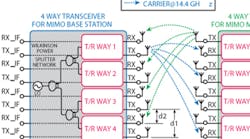Marking Mixers for the Next Application
Microwave mixers are essential building blocks for a fair share of high-frequency receivers. Mixers can be specified either as discrete components or as functions on integrated circuits (ICs), and they are critical to the performance of many different types of systems. For those who are new to high-frequency mixers and their basic operation, a 12-page application note from Marki Microwave, “Mixer Basics Primer: A Tutorial for RF & Microwave Mixers,” provides an excellent introduction. Written by company founder Ferenc Marki and his son, Christopher Marki, the application note examines the basic functions of mixers for communications systems, as well as how metrics can be used to compare the performance of different mixer types.
This informative application note explains the workings of an RF/microwave mixer in straightforward language, detailing the functions of the RF, local oscillator (LO), and intermediate-frequency (IF) ports. It provides the simple mathematical relationships of the three mixer signals and explains how a mixer can be used for frequency upconversion and downconversion alike.
Although the literature explains that almost any nonlinear device could be used to build a frequency mixer, certain devices are traditonally used in specific types of applications. For example, GaAs field-effect transistors (FETs) and silicon CMOS transistors often are used for mixers in applications where cost must be contained and performance is not critical. When performance is more of an issue, devices such as Schottky diodes (which are the nonlinear devices incorporated in Marki mixers) are typically employed for applications well into the microwave frequency range.
Both single-diode and multiple-diode mixers are reviewed for their strengths and weaknesses, with Schottky diodes providing optimal frequency-conversion performance for high-frequency mixers. Unfortunately, Schottky diodes also have their shortcomings, including some transconductance modulation in a diode which can result in additional, unwanted frequency components generated by a single-diode mixer. Multiple-diode mixers, based on four or eight diodes, are also examined; the note explores how some sacrifice in loss performance versus single-diode mixers can deliver frequency conversion with decreased modulation products.
The literature explains the design of how single-balanced mixers can be created with low loss and flexible operation using four diodes in a four-port hybrid junction configuration. This design approach offers higher conversion efficiency than a single-diode mixer with enhanced isolation between mixer RF and LO ports.
For anyone seeking a solid tutorial article on RF/microwave mixers, this application note explains the operation of these components and also reviews the chief performance parameters—including conversion loss, isolation, VSWR, noise figure, multitone intermodulation distortion (IMD), and 1-dB compression—and how they can be used to compare different mixer products for different applications. It is an excellent starting place for learning about mixers and how to specify them for frequency-conversion applications.
Marki Microwave, 215 Vineyard Ct., Morgan Hill, CA 95037; (408) 778-4200, FAX: (408) 778-4300
